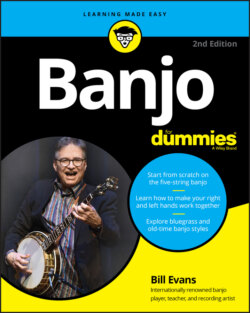Читать книгу Banjo For Dummies - Bill Evans - Страница 22
Picking up string vibrations
ОглавлениеWhen you strike a banjo string with a right-hand finger or thumb, the string starts to move back and forth. These vibrations move through the bridge (a piece of wood positioned on the banjo head) to the banjo head, which amplifies that sound. Banjo players frequently refer to right-hand playing as picking the banjo. You can read more about authentic right-hand banjo picking techniques in Chapter 5.
The pitch of any string (its sound as measured by how high or low it is) is determined by how much tension or tightness is in each string and how long or short it is. The tighter or shorter the string, the higher its pitch. You can change the pitch of a string in two ways:
Turn the tuning pegs. A twist of a tuning peg in one direction or the other raises or lowers the pitch of a string. The direction is different for each string. (For more on tuning, check out Chapter 2.)
Fret the strings. When you fret a string, you place a left-hand finger behind one of the 22 frets found on the fingerboard of the neck. As you fret, you're shortening the length of the string and raising its pitch. An open string is one that is unfretted in the left hand. A fretted string sounds higher in pitch compared to an open string or to that same string fretted on a lower fret (a lower fret is one that is farther away from the banjo body). For more on fretting with the left hand, see Chapter 3.
